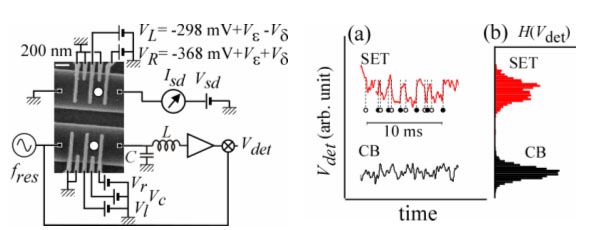Physical Science Laboratory
Electrical current is widely used in various electronic
systems, and is one of the fundamental measurement for electron transport
phenomena. However, the minimum detectable current is remained at around 105
-106 electrons/sec. Recent development in nanotechnology research enables
us to manipulate single electron in a small conductive island (quantum dot).
More recent activities are devoted to some applications, such as single-electron
transistors and memories, as well as physical interests on electronic states
in quantum dots. In this study, we have succeeded in observation of each electron
tunneling events through a quantum dot in real time scale, which is expected
to be applied to extremely sensitive ampere meter that counts how many electrons
has passed through a device.
In this work, we prepare two quantum dots (the upper one and the lower one)
coupled electrostatically, and the current through the upper dot can be detected
with a change in the current through the lower dot [1]. Electron counting
can be realized since the current through the lower dot decreases (increases)
when an electron enters (leaves) the upper quantum dot. The device used in
this study is shown in the SEM picture of Fig. 1. Two quantum dots (denoted
by circles) embedded in isolated two electrical channels is fabricated in
AlGaAs/GaAs modulation-doped heterostructure by etching process (dark regions)
and fine Schottkey gates (bright vertical lines). We feed a small current
through the upper quantum dot, and tunneling events can be measured with the
conductance through the lower dot. In order to improve the frequency band
width, high-frequency carrier signal (660 MHz) is introduced, and the transmitted
signal is amplified with LC resonator and detected with a mixer. The output
voltage, Vdet, is proportional to the conductance of the lower dot.
Figure 2(a) shows typical time dependent signal Vdet, when the upper quantum
dot is adjusted at the Coulomb blockade (CB) condition and at the single-electron
tunneling (SET) condition. Binary switching signal is appeared in the SET
condition, and double peak feature is observed in the histogram of Vdet taken
with a loger period (shown in Fig. 2(b)). Therefore, we are able to determine
when an electron enter the upper dot (denoted by white circles in Fig. 2(a))
and when an electron escape to the electrode (solid circles). In this case,
there are five tunneling events within the 10 ms period, corresponding to
0.08 fA of current. We expect to develop an electron counting device for either
current direction in future.
[1] T. Fujisawa et al., Appl. Phys. Lett. 84, 2343 (2004).
 |
||
|
Fig. 1. Measurement system and an electron counting
device. |
Fig. 2. Single-electron counting (SET) and background noise (CB) | |